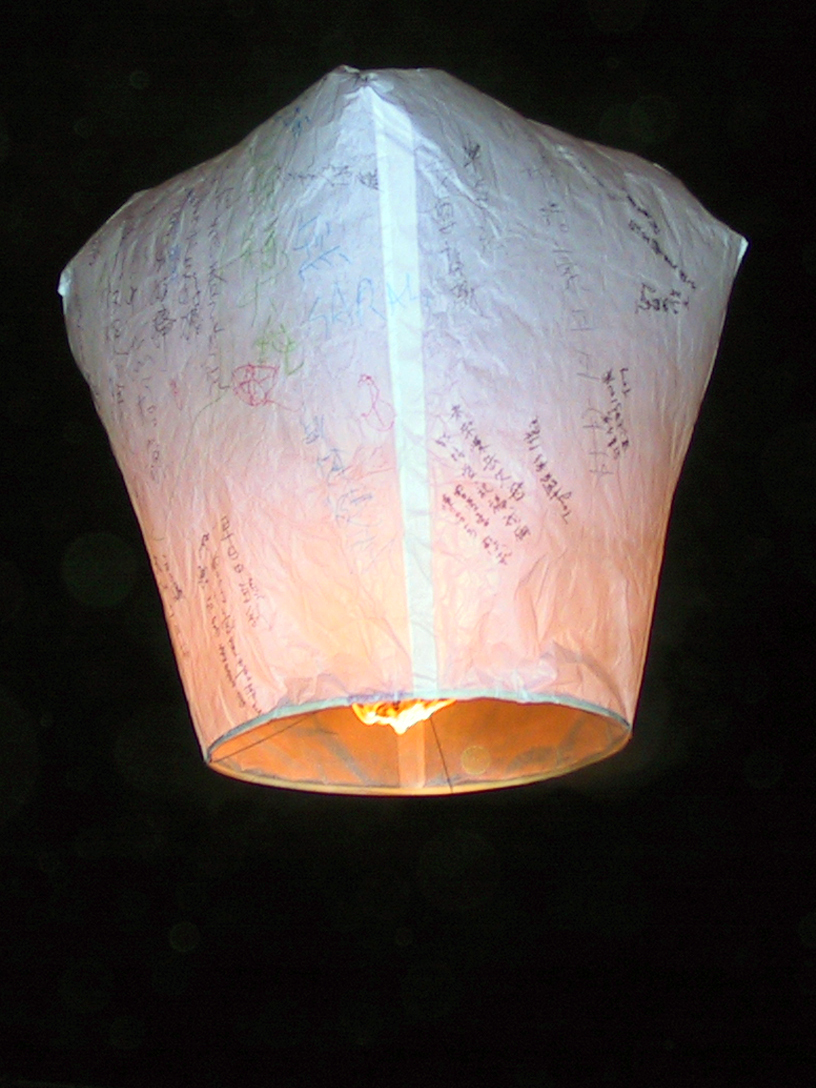|
Kamifūsen
The term refers to several types of paper balloons in Japanese culture. They are simple toys for children, advertising give-aways for traditional medicine companies, and illuminated flying balloons at festivals. Smaller kamifūsen are popular as traditional children's toys in Japan. These have an open hole, and reinflate as they are bounced in play. The balloon is made of glassine paper known as washi, which is air-resistant, glossy and thin, and which has sufficient plasticity to allow it to be formed into a new shape, which it can then retain. The properties of these paper balloon toys are of interest to scientists. Traditionally, kamifūsen were sold in dagashiya, small shops selling candy, snacks and inexpensive toys to schoolchildren as an alternative to the more expensive rubber balloon. They are now sold in souvenir shops and online. Another variation, known as the is in the shape of a cube rather than a sphere, and is associated with the marketing campaigns of tra ... [...More Info...] [...Related Items...] OR: [Wikipedia] [Google] [Baidu] |
Sky Lanterns
A sky lantern (), also known as Kǒngmíng lantern (), or Chinese lantern, is a small hot air balloon made of paper, with an opening at the bottom where a small fire is suspended. In Asia and elsewhere around the world, sky lanterns have been traditionally made for centuries, to be launched for play or as part of long-established festivities. The name ''sky lantern'' is a translation of the Standard Chinese, Chinese name but they have also been referred to as ''sky candles'' or ''fire balloons''. In Thai, they are known as ''khom loi''. Several fires have been attributed to sky lanterns, with at least one 21st-century death caused. Sky lanterns have been made illegal in several countries. Many areas of Asia do not permit sky lanterns because of widespread fire hazards as well as danger to livestock. Construction The general design is a thin paper shell, which may be from about 30 centimetre, cm to a couple of metres across, with an opening at the bottom. The opening is ... [...More Info...] [...Related Items...] OR: [Wikipedia] [Google] [Baidu] |
Paper Lantern
A paper lantern is a lantern made of thin, brightly colored paper. Paper lanterns come in various shapes and sizes, as well as various methods of construction. In their simplest form, they are simply a paper bag with a candle placed inside, although more complicated lanterns consist of a collapsible bamboo or metal frame of hoops covered with tough paper. Origin Paper lanterns are likely derived from earlier lanterns that used other types of translucent material like silk, horn, or animal skin. The material covering was used to prevent the flame in the lantern from being extinguished by wind, while still retaining its use as a light source. Papermaking technology originated from China from at least AD 105 during the Eastern Han Dynasty, but it is unknown exactly when paper became used for lanterns. Poems about paper lanterns start to appear in Chinese history at around the 6th century. Paper lanterns were common by the Tang Dynasty (AD 690–705), and it was during this period ... [...More Info...] [...Related Items...] OR: [Wikipedia] [Google] [Baidu] |
Tora-san's Promise
, also called ''Torasan and a Paper Balloon'' in some regions, is a 1981 Japanese comedy film directed by Yoji Yamada. It stars Kiyoshi Atsumi as Torajirō Kuruma (Tora-san), and Mikiko Otonashi as his love interest or "Madonna". ''Tora-san's Promise'' is the twenty-eighth entry in the popular, long-running ''Otoko wa Tsurai yo'' series. Synopsis Tora-san returns to his family's home to attend an elementary school class reunion. After he embarrasses himself by getting drunk and insulting all his ex-classmates, he resumes his travels. In Kyushu he meets an outspoken 18-year-old girl who becomes enamored of Tora-san and follows him around. One of Tora-san's old friends is terminally ill and makes Tora-san promise him to marry his wife once he is gone. Cast * Kiyoshi Atsumi as Torajirō * Chieko Baisho as Sakura * Mikiko Otonashi as Mitsue Kuratomi * Kayoko Kishimoto as Aiko Odajima * Shimojo Masami as Kuruma Tatsuzō * Chieko Misaki as Tsune Kuruma (Torajiro's aunt) * Hiroshi Inuzu ... [...More Info...] [...Related Items...] OR: [Wikipedia] [Google] [Baidu] |
Sky Lantern
A sky lantern (), also known as Kǒngmíng lantern (), or Chinese lantern, is a small hot air balloon made of paper, with an opening at the bottom where a small fire is suspended. In Asia and elsewhere around the world, sky lanterns have been traditionally made for centuries, to be launched for play or as part of long-established festivities. The name ''sky lantern'' is a translation of the Chinese name but they have also been referred to as ''sky candles'' or ''fire balloons''. In Thai, they are known as ''khom loi''. Several fires have been attributed to sky lanterns, with at least one 21st-century death caused. Sky lanterns have been made illegal in several countries. Many areas of Asia do not permit sky lanterns because of widespread fire hazards as well as danger to livestock. Construction The general design is a thin paper shell, which may be from about 30 cm to a couple of metres across, with an opening at the bottom. The opening is usually about 10 to 30 c ... [...More Info...] [...Related Items...] OR: [Wikipedia] [Google] [Baidu] |
Inflatable Manufactured Goods
An inflatable is an object that can be inflated with a gas, usually with air, but hydrogen, helium and nitrogen are also used. One of several advantages of an inflatable is that it can be stored in a small space when not inflated, since inflatables depend on the presence of a gas to maintain their size and shape. Function fulfillment per mass used compared with non-inflatable strategies is a key advantage. Stadium cushions, impact guards, vehicle wheel inner tubes, emergency air bags, and inflatable space habitats employ the inflatable principle. Inflation occurs through several strategies: pumps, ram-air, blowing, and suction. Although the term ''inflatable'' can refer to any type of inflatable object, the term is often used in boating to specifically refer to inflatable boats. Types High-pressure vs. low-pressure A distinction is made between high-pressure and low-pressure inflatables. In a high-pressure inflatable, structural limbs like pillars and arches are built out ... [...More Info...] [...Related Items...] OR: [Wikipedia] [Google] [Baidu] |
Paper Toys
Paper toys are toys made of paper. They are constructed in several ways, by folding, as in paper airplanes, paper fortune tellers or Origami, or by cutting, decorating or assembling pieces of paper with glue or tape to create a paper doll or paper model. History Paper toys date back to ancient times. The history of paper toys can be traced back to the art of origami (or-i-GA-me).The word is based on the Japanese words ''Ori'', which means to fold, and ''Kami'', which means paper. However origami's roots are from China and it spread to Japan somewhere around the sixth century. The craft was for only the rich at first because the cost of paper was very high. They found useful ways to use the folded paper. For example, they would fold it with strips of dried meat or fish and this was called Noshi, which was a token of good luck. Also they would often wrap the glasses of wine at a wedding into butterfly form to represent the bride and groom. As time went by new methods of making p ... [...More Info...] [...Related Items...] OR: [Wikipedia] [Google] [Baidu] |
Novelty Items
Novelty (derived from Latin word ''novus'' for "new") is the quality of being new, or following from that, of being striking, original or unusual. Novelty may be the shared experience of a new cultural phenomenon or the subjective perception of an individual. From the meaning of being unusual usage is derived the concept of the novelty dance (a type of dance that is popular for being unusual or humorous); the novelty song (a musical item that capitalizes on something new, unusual, or a current fad); the novelty show (a competition or display in which exhibits or specimens are in way some novel); and novelty architecture (a building or other structure that is interesting because it has an amusing design). It is also this sense that applies to a novelty item, a small manufactured adornment, toy or collectible. These, in turn are often used as promotional merchandise in marketing. The Glossary of chess#N, chess term, novelty, is used for a move in chess which has never been played bef ... [...More Info...] [...Related Items...] OR: [Wikipedia] [Google] [Baidu] |
Balloons (entertainment)
A balloon is a flexible bag that can be inflated with a gas, such as helium, hydrogen, nitrous oxide, oxygen, and air. For special tasks, balloons can be filled with smoke, liquid water, granular media (e.g. sand, flour or rice), or light sources. Modern day balloons are made from materials such as rubber, latex, polychloroprene, or a nylon fabric, and can come in many different colors. Some early balloons were made of dried animal bladders, such as the pig bladder. Some balloons are used for decorative purposes or entertaining purposes, while others are used for practical purposes such as meteorology, medical treatment, military defense, or transportation. A balloon's properties, including its low density and low cost, have led to a wide range of applications. The rubber balloon was invented by Michael Faraday in 1824, during experiments with various gases. He invented them for use in the lab. Applications Play Decoration Balloons are used for decorating birthday part ... [...More Info...] [...Related Items...] OR: [Wikipedia] [Google] [Baidu] |
Fu-Go Balloon Bomb
was an deployed by Japan against the United States during World War II. A hydrogen balloon measuring in diameter, it carried a payload of two incendiary devices plus one anti-personnel bomb (or alternatively one incendiary bomb), and was intended to start large forest fires in the Pacific Northwest. Between November 1944 and April 1945, the Japanese launched about 9,300 balloons from sites on Honshu, of which about 300 were found or observed in the U.S., with some in Canada and Mexico. The balloons traveled on high-altitude and high-speed currents over the Pacific Ocean, today known as the jet stream, and used a sophisticated ballast system to control altitude on their three-day flight. Despite high hopes for the operation, the bombs were largely ineffective due to damp conditions and malfunctions, causing only minor damage and six deaths (from a single civilian incident in Oregon in May 1945). The Fu-Go balloon bomb was the first weapon to possess intercontinental range, ... [...More Info...] [...Related Items...] OR: [Wikipedia] [Google] [Baidu] |
Humanity And Paper Balloons
is a 1937 Japanese jidaigeki film directed by Sadao Yamanaka. It was Yamanaka's last film before his death. Plot The film is set in feudal Japan during the 18th century, an era known as the Edo period. It depicts the struggles and schemes of Matajuro Unno, a rōnin, or masterless samurai, and his neighbor Shinza, a hairdresser. The story begins in a slum where poor families perform menial jobs. Shinza, though a hairdresser by trade, actually makes his living by running illicit gambling rooms and pawning his belongings. Unno, who lives with his wife next door, is the son of Matabei Unno, a great samurai. Since his father's death, Unno has struggled to find work and hopes that Mouri, his father's former master, will hire him after reading a letter from his father. Mouri avoids Unno and finds excuses not to read his father's letter. Nevertheless, Unno seeks out Mouri every day and follows him wherever he goes. Mouri tries to get rid of Unno by sending a gang of men to intimidate ... [...More Info...] [...Related Items...] OR: [Wikipedia] [Google] [Baidu] |






.jpg)
_1.jpg)